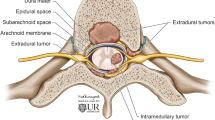Abstract
Objective
To describe the CT features of an unusual type of lumbar Schmorl’s node (SN) appearing as giant fatty lesion of the vertebral bodies.
Design and patients
>Four patients (4 men; mean age 48.5 years) collected during a 9-month period were examined with MDCT for unremarkable lumbar symptoms; none had relevant history of specific trauma during the last years preceding the CT.
Results and conclusions
The CT findings had a similar showing: a central or para-central osteolytic lesion in contact with the upper end plate of the vertebra, occupying about two-thirds to three-quarters of the body height and being surrounded by a thin and well-delineated bony rim. There was a clear interruption of the superior vertebral end plate above the lesion and an almost normal height of the adjacent vertebral disk. The CT appearance suggested a uniform fat content which was confirmed by density measurements ranging from −20 to −30 HU. The origin remains unknown, but a parallel is drawn between giant fatty SNs and giant cystic SNs. Intravertebral disk herniation is likely to be the initial phenomenon, with a preponderant responsibility of the “secondary induced intramedullar tissular disorders” to constitute the final size of the lesion. One hypothesis could be a fracture of trabecular bone with secondary hemorrhage and cystic or fatty degeneration. Alternatively, intramedullary vascular disturbances may lead to foci of bone necrosis that heal by fibroblastic proliferation followed by mucoid or fatty degeneration. It is also possible that giant fatty SNs could represent end stage of giant cystic SNs.





Similar content being viewed by others
References
Pfirrmann C, Resnick D. Schmorl nodes of the thoracic and lumbar spine: radiographic–pathologic study of prevalence, characterization, and correlation with degenerative changes of 1,650 spinal levels in 100 cadavers. Radiology 2001; 219:368–374.
Jevtic V Magnetic resonance imaging appearances of different discovertebral lesions. Eur Radiol 2001; 11:1123–1135.
Vande Berg B, Galant C, Lecouvet FE, Maldague B, Cosnard G, Malghem J. The lumbar vertebral body and discovertebral junction. Radio MR imaging anatomic correlations. Radiol Clin North Am 2000; 38:1153–1175.
Wagner AL, Murtagh FR, Arrington JA, Stallworth D. Relationship os Schmorl’s nodes to vertebral body endplate fracture and acute endplate disk extrusions. AJNR 2000; 21:276–281.
Seymour R, Williams LA, Rees JI, Lyons K, Lloyd DCF. Magnetic resonance imaging of acute intraosseous disc herniation. Clin Radiol 1998; 53:363–368
Scarfo GB, Muzi VF, Mariottini A, Bolognini A, Cartolari R. Posterior Retroextramarginal Disc Hernia (PREMDH): definition, diagnosis and treatment. Surg Neurol 1996; 46:205–211.
Leroux JL, Fuentes JM, Baixas P, Benezech J, Chertok P, Blotman F. Lumbar posterior marginal node (LMPN) in adults. Spine 1992; 12:1505–1508.
Coulier B, Ghosez JP. Lumbar radiculopathy caused by a tunneling tranvertebral Schmorl’s node. Skeletal Radiol 2002; 31:484–487.
Hauger O, Cotten A, Chateil JF, Borg O,Moinard M, Diard F. Giant cystic Schmorl’s nodes: imaging findings in six patients. AJR 2001; 176:969–972.
Resnick D, Niwayama G. Intervertebral disk herniations: cartilaginous (Schmorl’s) nodes. Radiology 1978; 126:57–65.
Leibner ED, Floman Y. Tunneling Schmorl’s nodes. Skeletal Radiol 1998; 27:225–227.
Leone A, Cerase A, Equitani F, Pagano L. Tunneling Schmorl’s nodes in an elderly woman treated for acute lymphoblastic leukaemia. Skeletal Radiol 2000; 29:660–663.
Stäbler A, Bellan M, Weiss M, Gärtner C, Brossman J, Reiser MF. MR imaging of enhancing intraosseous disc herniation (Schmorl’s nodes). AJR 1997; 168:933–938.
Hilton RC, Ball J, Benn RT. Vetrebral endplate lesions (Schmorl’s nodes) in the dorsolumbar spine. Ann Rheum Dis 1976; 35:127–132
Resnick D. Degenerative disease of extraspinal locations. In: Resnick D, editor. Diagnosis of bone and joint disorders, 3rd edn. Philadelphia: Saunders, 1995:1263–1371.
Author information
Authors and Affiliations
Corresponding author
Rights and permissions
About this article
Cite this article
Coulier, B. Giant fatty Schmorl’s nodes: CT findings in four patients. Skeletal Radiol 34, 29–34 (2005). https://doi.org/10.1007/s00256-004-0858-7
Received:
Revised:
Accepted:
Published:
Issue Date:
DOI: https://doi.org/10.1007/s00256-004-0858-7




